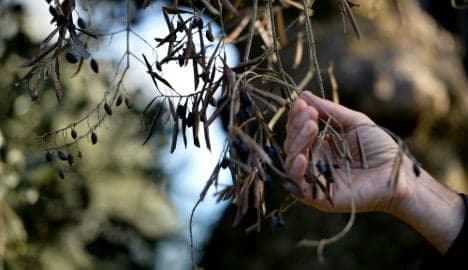'No cure' for deadly disease ravaging Italy's olive trees

There is still no known cure for the olive-tree-killing Xylella bacteria, the European Food Safety Agency (EFSA) said on Wednesday, warning that it poses a risk to plants and crops throughout Europe.
Xylella fastidiosa, a deadly bacterial pathogen, was was first detected in 2013 when an outbreak hit olive trees in the southern Italian region of Puglia, causing scores of ancient trees to die off.
Experts have so far been unable to explain where the disease came from.
Since 2013, cases of Xylella infection have been reported in Tuscany as well as France, Spain and Portugal.
READ ALSO:
And EFSA warned in its latest report that strains of the bacteria could potentially spread throughout Europe, including northern areas.
More than a million trees, ten percent of Salento's total, are estimated to have been infected in a a region where abundant olive groves filled with centuries-old trees are synonomous with the timeless landscape.
Most of those that have been infected have or will soon become stunted, leafless and ultimately lifeless, thoug it is unknown how far the bacteria may have spread.
Experts warn that the trees may be infected for up to a year before signs begin to show.
What is clear is that the potential damage is huge. Xylella does not harm humans but can kill over 200 types of plant, including fruit trees and grape vines.
EU emergency control measures are in place in all of the outbreak areas, although there has been resistance from some growers to the massive tree culls ordered as part of the plan in southern Italy.
The EFSA stressed in its report that control measures ae "crucial" until a cure can be found.
"EFSA used computer modelling to simulate how X. fastidiosa spreads across short and long distances under different conditions," the agency said.
"The modelling showed the importance of implementing control measures, such as those specified by the European Commission, to prevent further spread and even eradicate outbreaks".
Some 66 percent of the world's olive oil is produced in Europe, according to EU figures. Italy is the second-largest producer of olive oil after Spain.
The xylella outbreak was blamed for a steep increase in olive oil prices in 2015.
READ ALSO: US vows to put tariffs on products including Italian olive oil, prosecco and cheese
Comments
See Also
Xylella fastidiosa, a deadly bacterial pathogen, was was first detected in 2013 when an outbreak hit olive trees in the southern Italian region of Puglia, causing scores of ancient trees to die off.
Experts have so far been unable to explain where the disease came from.
Since 2013, cases of Xylella infection have been reported in Tuscany as well as France, Spain and Portugal.
READ ALSO:
And EFSA warned in its latest report that strains of the bacteria could potentially spread throughout Europe, including northern areas.
More than a million trees, ten percent of Salento's total, are estimated to have been infected in a a region where abundant olive groves filled with centuries-old trees are synonomous with the timeless landscape.
Most of those that have been infected have or will soon become stunted, leafless and ultimately lifeless, thoug it is unknown how far the bacteria may have spread.
Experts warn that the trees may be infected for up to a year before signs begin to show.
What is clear is that the potential damage is huge. Xylella does not harm humans but can kill over 200 types of plant, including fruit trees and grape vines.
EU emergency control measures are in place in all of the outbreak areas, although there has been resistance from some growers to the massive tree culls ordered as part of the plan in southern Italy.
The EFSA stressed in its report that control measures ae "crucial" until a cure can be found.
"EFSA used computer modelling to simulate how X. fastidiosa spreads across short and long distances under different conditions," the agency said.
"The modelling showed the importance of implementing control measures, such as those specified by the European Commission, to prevent further spread and even eradicate outbreaks".
Some 66 percent of the world's olive oil is produced in Europe, according to EU figures. Italy is the second-largest producer of olive oil after Spain.
The xylella outbreak was blamed for a steep increase in olive oil prices in 2015.
READ ALSO: US vows to put tariffs on products including Italian olive oil, prosecco and cheese
Join the conversation in our comments section below. Share your own views and experience and if you have a question or suggestion for our journalists then email us at [email protected].
Please keep comments civil, constructive and on topic – and make sure to read our terms of use before getting involved.
Please log in here to leave a comment.